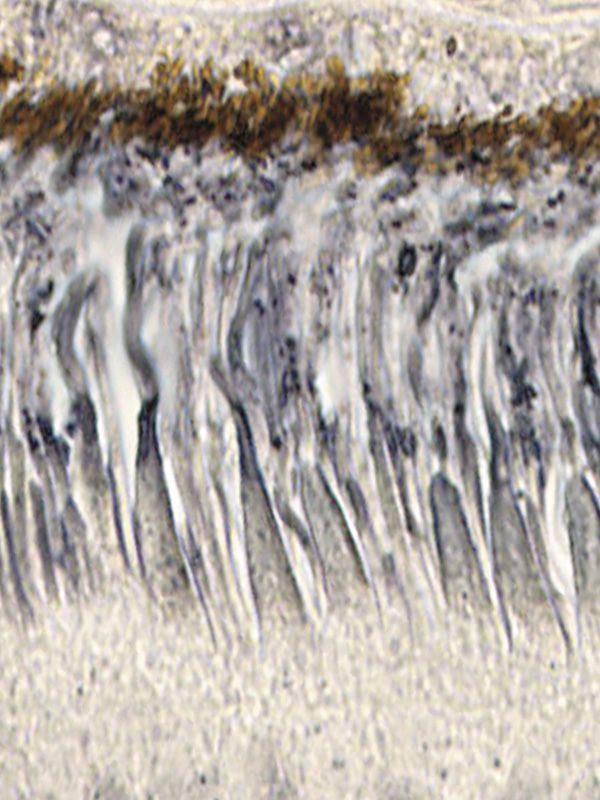Article
Trophic factor replacement targets most debilitating effects of RP
Degeneration of rods in eyes with RP leads to night vision problems and loss of rod-derived cone viability factor (RdCVF) that is necessary for cone survival. Replacing RdCVF may prevent cone degeneration and loss of central vision.
Take-Home Message: Degeneration of rods in eyes with RP leads to night vision problems and loss of rod-derived cone viability factor (RdCVF) that is necessary for cone survival. Replacing RdCVF may prevent cone degeneration and loss of central vision.

(Figure 1) Immunohistochemical analysis of the expression of basigin-1, the rod-derived cone viability factor cell surface receptor, in the macaque retina. Basigin-1 expression localized to inner segments and outer segments of cones, identified by their unique morphology. Brown color on the top: Retinal pigmented epithelium. (Image courtesy of Thierry Léveillard, PhD)
By Cheryl Guttman Krader; Reviewed by Thierry Léveillard, PhD
Paris-Replacement of rod-derived cone viability factor (RdCVF) is being looked to as a potential strategy for maintaining cone-mediated central vision in patients with retinitis pigmentosa (RP), according to Thierry Léveillard, PhD.
“As RdCVF is a trophic factor that promotes the survival of cones, its replacement could maintain cone viability and prevent the loss of central vision that is the major handicap occurring with RP,” said Dr. Léveillard, director of research, Institut National de Santé et de Recherche Médicale (INSERM), The Vision Institute, Pierre and Marie Curie University, Paris, France.
“This approach is not a cure for RP since it does not correct a genetic defect that causes the disease,” Dr. Léveillard explained.
“However, genetic approaches to RP treatment are limited by the fact that RP is a genetically heterogeneous disease with 54 identified causative genes,” Dr. Léveillard said. “Replacement of RdCVF is an attractive strategy because it addresses a common pathway leading to cone degeneration, regardless of the causative mutation.”
Dr. Léveillard and José Sahel, MD, professor of ophthalmology, Pierre and Marie Curie University, reported the first fundamental discovery of RdCVF in mice in the journal Nature Genetics in 2004. Since then, they have published several papers describing their research findings and presented some of their most recent studies at the 2015 meeting of the Association for Research in Vision and Ophthalmology.
Supporting evidence
Evidence to support RdCVF replacement as a useful treatment in RP is available from preclinical studies demonstrating that it protected cone function in two genetically distinct animal models of RP.

Dr. Léveillard
“The fact that we observed efficacy in both models supports the belief that RdCVF should maintain cone viability independent of the genetic cause for RP,” Dr. Léveillard said.
Evidence from humans of the importance of RdCVF as a trophic factor for cones derives from analyses of surgical specimens from eyes with retinal detachment and eyes with RP.
“We found reduced expression of RdCVF in the retinal detachment surgical specimens, which is relevant to RP because photoreceptor degeneration also occurs during retinal detachment,” Dr. Léveillard said. “In addition, we identified the presence of the surface receptor for RdCVF on surviving cones in the retina from eyes with RP.”
May restore vision
Knowing that there are impaired surviving cones in eyes with RP and based on understanding the mechanism of RdCVF, the researchers are also postulating that RdCVF replacement may restore lost vision and not just stabilize it.
“RdCVF acts to sustain renewal of the cone outer segments, which is an ongoing phenomenon,: Dr. Léveillard said. “While it will have to be proven, it is plausible that the cones may regrow under the stimulation of RdCVF.”
Preclinical research leading up to clinical testing of RdCVF replacement is underway and two-thirds completed. The viral vector that will be used to deliver the RdCVF-expressing gene has been identified and validated. It is the same adeno-associated virus that is being used to deliver the RPE65 gene for Leber congenital amaurosis.
In addition, the criteria for defining the population of patients who will be enrolled in the first clinical study have been determined. As a last step, a safety study is underway in a non-human primate model.
“This study is mandated by regulatory requirements, but we are optimistic about the results because RdCVF is not a foreign substance and the vector we are using for gene delivery also has established safety,” Dr. Léveillard said.
Thierry Léveillard, PhD
E: thierry.leveillard@inserm.fr
This article was adapted from a poster presentation at the 2015 meeting of the Association for Research in Vision and Ophthalmology. Dr. Léveillard holds a patent on the use of RdCVF for the treatment of retinal and neurological disease.





